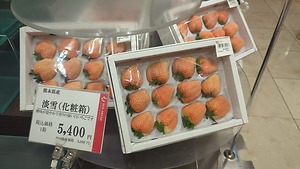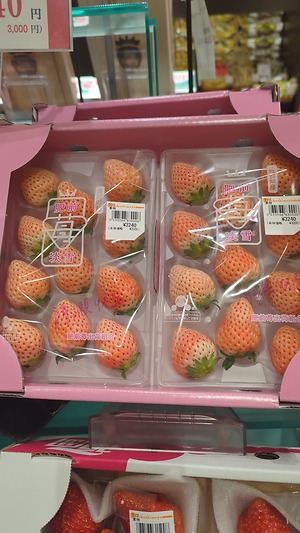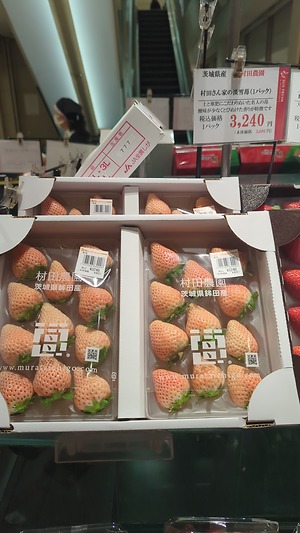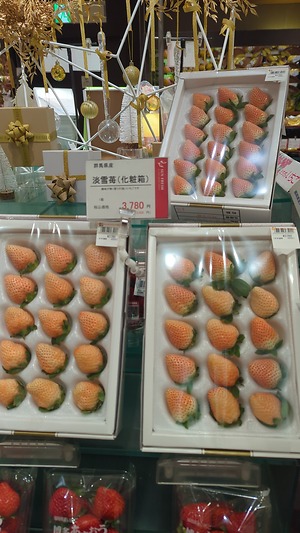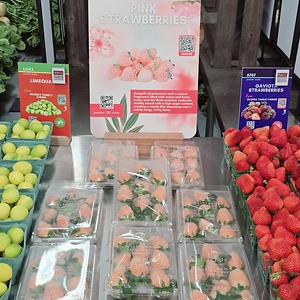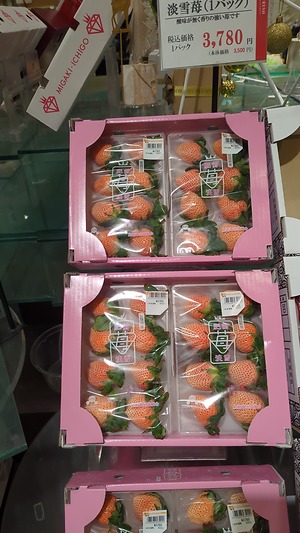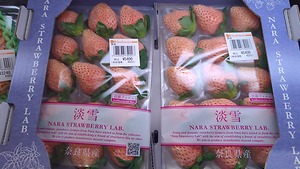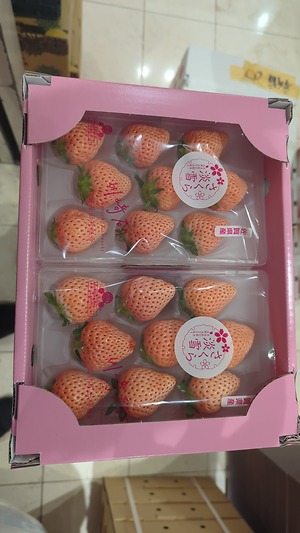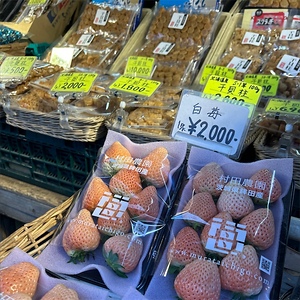

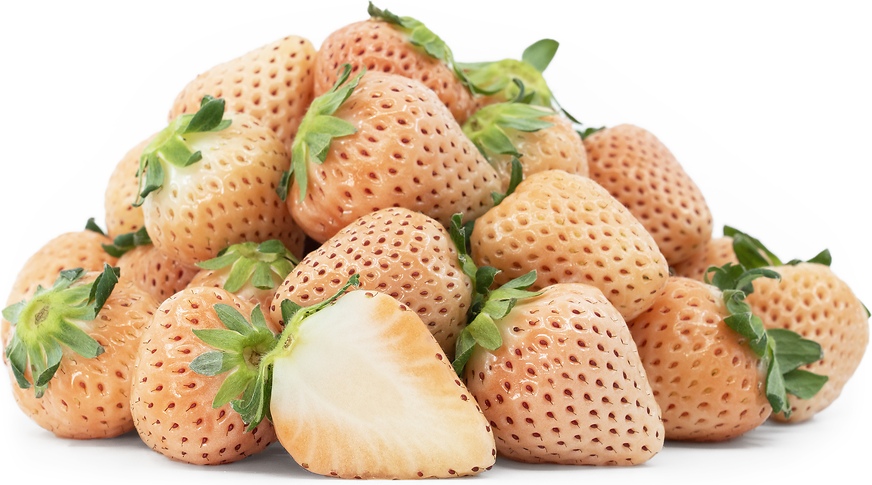
Awayuki Strawberries
Estimated Inventory, 200 gm : 0
This item was last sold on : 05/11/25
Description/Taste
Awayuki strawberries are generally small to medium fruits, averaging 2 to 4 centimeters in diameter, and have a uniform appearance with broad, curved shoulders, gently sloping into a tapered, blunt tip. The fruit’s skin is glossy, smooth, and textured, speckled with dark red seeds, and each strawberry is capped with a dark leafy green, flat top. Awayuki strawberries have a distinct coloring, often marketed as cherry-blossom pink, and bear light pink hues with subtle white undertones. Underneath the surface, the pink shades continue into the flesh, eventually transitioning into a white center. The flesh is fine-grained, tender, aqueous, and light with a crisp but soft, melting consistency. Awayuki strawberries emit a robust fragrance filled with sweet and fruity notes, and the flesh contains moderate acidity mixed with a high sugar content, creating a candy-like sweetness and a subtly tangy, fruity taste.
Seasons/Availability
Awayuki strawberries are available in the winter through early spring in Japan.
Current Facts
Awayuki strawberries, botanically a part of the Fragaria genus, are a rare, light pink variety belonging to the Rosaceae family. The delicate fruits are premium strawberries highly prized for their aroma, flavor, appearance, and texture. The name Awayuki translates from Japanese to mean “light snow,” a descriptor that was given in honor of the fruit’s delicate texture and coloring. Awayuki strawberries obtain their unusual pink-hue from the natural process of restricting sunlight during cultivation. As the strawberries develop without normal levels of sunlight, the colored pigment responsible for the fruit’s signature red hue, anthocyanins, is reduced, creating light pink fruits. Awayuki strawberries are only cultivated through a few farms across Japan and are grown for the Japanese luxury fruit market. The fruits are produced under a strict set of cultivation standards, contributing to the variety’s crisp but tender texture and sweet flavor, and once mature, the strawberries are harvested and packaged by hand, selecting the fruits with the best color, shape, and appearance.
Nutritional Value
Awayuki strawberries are a source of vitamin C, an antioxidant that protects the body against free radical damage while strengthening the immune system and reducing inflammation. The fruits may also provide some potassium to balance fluid levels in the body, calcium to protect bones and teeth, and lower amounts of zinc, manganese, iron, and magnesium.
Applications
Awayuki strawberries are traditionally served fresh, out-of-hand to showcase the fruit’s coloring, soft texture, and sweet, mildly tangy flavor. When consumed, the specialty fruits are typically placed whole on decorative platters or are consumed directly from the gift box, which is part of the fruit’s visual presentation. In Japan, Awayuki strawberries are served with condensed milk as a sweet accompaniment, similar to the way Americans eat strawberries dipped in chocolate, or they are wrapped in a thin layer of mochi or incorporated as a fancy topping over shortcakes, tarts, whipped cream-based desserts, and other cakes. The fruits are also used as an ingredient to attract foodies to restaurants. In Singapore, Flipper’s, a well-known Japanese pancake chain, used sliced Awayuki strawberries on top of a stack of souffle pancakes as their signature item to draw visitors during their grand opening. Only 30 orders of the pancakes were made per day for the first couple of weeks, and despite each pancake stack only containing two chopped Awayuki strawberries, the entrée frequently sold out daily. Beyond fresh applications, Awayuki strawberries are also simmered into custom jams and jellies. The Nara Strawberry Lab in Japan develops Awayuki strawberry jam and exports it to MGM hotel properties in Las Vegas as a hospitality gift. Awayuki strawberries pair well with chocolate, vanilla, condensed milk, cream, cinnamon, caramel, and other fruits, including blueberries, raspberries, and peaches. Whole Awayuki strawberries have a short shelf life and should be consumed immediately for the best flavor and texture. The fruits can also be stored in the refrigerator for an additional 2 to 3 days.
Ethnic/Cultural Info
Awayuki strawberries are a favored gift in Japan, given for celebrations, including weddings, housewarming parties, birthdays, and holidays. The history of gifting fruits in Japan stems from the available lack of space within households. Fruits are considered consumable goods that can be enjoyed but will not take up precious space. Fruit gifting also stemmed from the Japanese belief in quality food. Japanese farmers are restricted in cultivation due to the lack of growing space, so many farmers choose to produce exceptional fruits with unusual flavors and characteristics. Quality fruits are appreciated as rare, precious commodities and are a sign of respect when given to friends, family, and colleagues. Strawberries, including Awayuki, are especially favored in Japan, and depending on the quality, the gift-wrapped fruits can range from less than one hundred dollars to thousands of dollars. In an auction held in Osaka in 2020, a gift box filled with 108 luxury strawberries, including 36 Awayuki strawberries, was sold for 1.5 million yen, the equivalent of $13,700. Gifted Awayuki strawberries are also often presented in elaborate, decorative boxes. Each strawberry is hand-selected and individually placed in its spot within the box to prevent the fruits from touching and bruising.
Geography/History
Japan has developed a reputation for quality strawberries worldwide, and the island country has cultivated over 312 different varieties of strawberries, with approximately 50 cultivars being commercially grown and sold in supermarkets, grocers, and through local farms. Awayuki strawberries are native to Japan and were believed to have been developed sometime in the 21st century, but much of the variety’s history remains unknown. Today Awayuki strawberries are grown through select strawberry farms throughout Japan, located in the Saga, Fukuoka, Kumamoto, Nara, and Ibaraki Prefectures. The fruits are primarily sold locally, but they are also exported on a limited basis through distributors to the United States, Singapore, Korea, and China.



